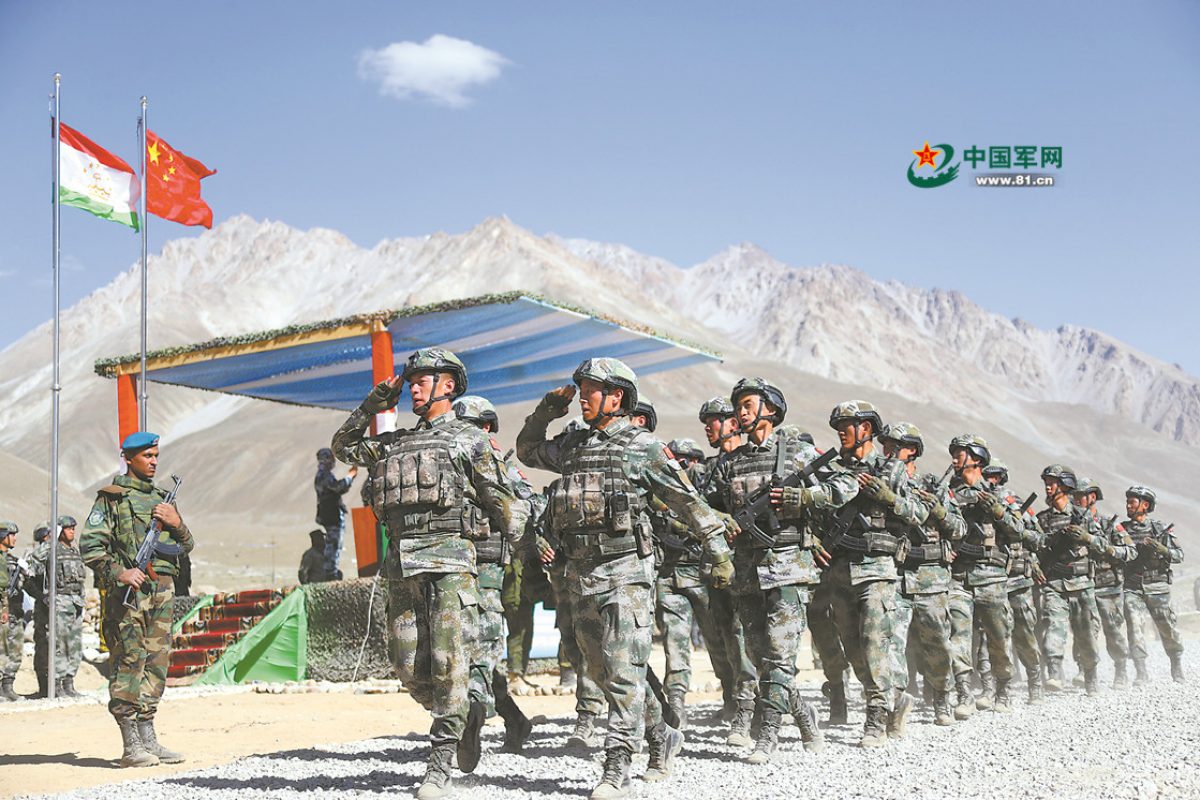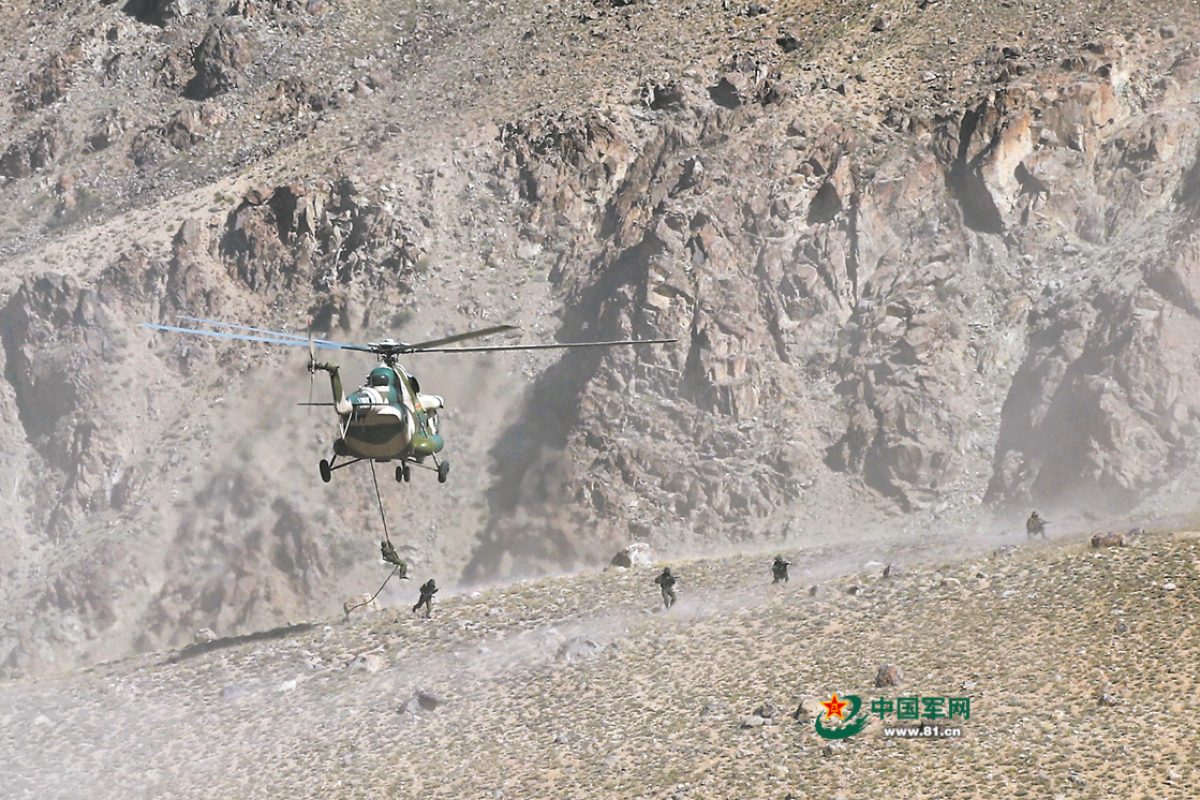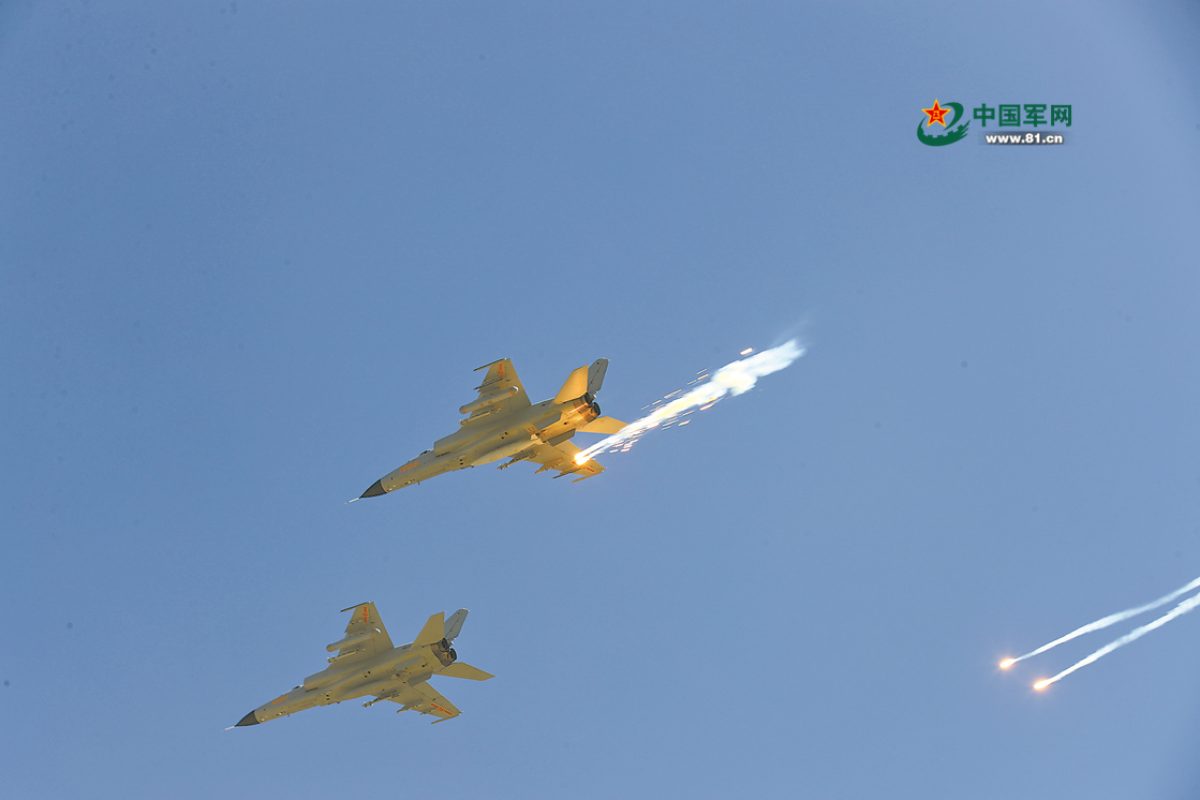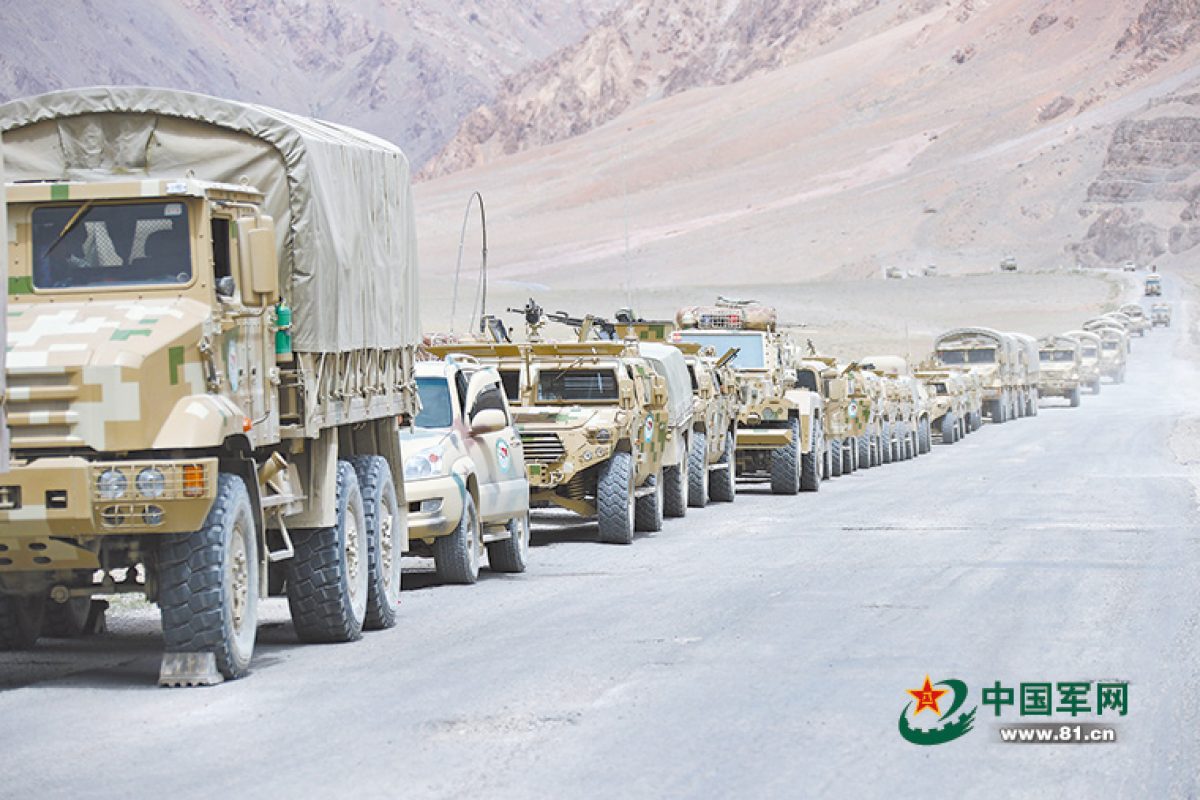«Would the excessive economic dependence on China lead to an equally excessive dependence on geopolitics, security and the military? In the end, there is a well-known axiom, which has come from world history and political science – economic dependence will eventually turn into political and military dependence», – said Tajik political analyst Parviz Mullodzhanov, in his article written specifically for CABAR.asia.
Follow us on Facebook
Joint Tajik-Chinese military field exercises – “Cooperation-2019” in GBAO. Photo: mod.gov.cn
Recent joint Tajik-Chinese military field exercises – “Cooperation-2019” in GBAO (Gorno-Badakhshan Autonomous Oblast) have attracted attention both in Tajikistan and abroad, caused widespread discussion in the press and on the Internet.[1] It would seem that bilateral military field exercises should not cause such a resonance. Particularly, both states have an agreement on cooperation in the field of security and counter-terrorism.
According to official reports, the military field exercises were carried out with the aim of working out cooperation in repelling the possible breakthrough by militants of jihadist groups across the Tajik-Afghan border. According to the Tajik border service, to date, in the northern regions of Afghanistan several thousand extremists have accumulated, where natives from the post-Soviet republics and Chinese Xinjiang also take part.[2]
Following the official logic, these military filed exercises are in the interests of both parties, and should not cause any special questions either from the partners of Tajikistan in the CSTO, or in the Tajik society itself. Moreover, the scale of this military field exercise is small, where only one battalion from the Tajik side and one troop from the Chinese side are involved.
However, several circumstances explain why a small-scale military field exercise have suddenly acquired a character value in the eyes of the international community and many other observers. These circumstances cause many questions that require a deeper analysis and remain unanswered to date.
The main concern is the fact that the growth of Sino-Tajik military cooperation is taking place against the background of the rapidly growing economic dependence of Tajikistan on China. Today, China is already the main creditor of Tajikistan, becoming also the main investor and trading partner of the country, which has long pushed Russia and other CIS countries into the middle ground.

Under these conditions, a quite reasonable question arises: Would the excessive economic dependence on China lead to an equally excessive dependence on geopolitics, security and the military? In the end, there is a well-known axiom, which has come from world history and political science – economic dependence will eventually turn into political and military dependence.

The fight against terror? Or…
If China invests hundreds of millions of dollars in the country’s economy, then in the future it may well declare its right to protect its investments – under the pretext that its economic interests are threatened in the event of political destabilization or any other actions of local governments.
It follows with a high degree of probability that the fight against terrorism is only one of the reasons for the joint military field exercises in GBAO – which in fact is far down the list of priorities. Indeed, it is rather difficult to believe in the possibility of Uyghur militants breaking through two borders into China. It is also hard to believe that the breakthrough of several hundred jihadists could even pose a serious threat to the Chinese People’s Army or the territorial integrity of China.
In fact, the strategic task for the PRC today is to protect its large-scale, multi-billion foreign projects and investments. First of all, we are talking about the strategic project “One Belt, One Road” within the framework of which about 60 billion US dollars are supposed to be invested in post-Soviet Central Asia alone.
Map of the One Belt One Road Initiative in Central Asia
The strategic scope of the project is also evidenced by the fact that at the end of April 2019 it already covered 126 countries, on the territory of which 63% of the world’s population lives. To implement this project, the Chinese leadership has entered into agreements with 29 international organizations, and the expected economic scale is estimated at 21 trillion US dollars.

The essence of the project is to create in the world and, above all, around China, a belt of transport and trade infrastructure, which would provide access to local mineral resources and trade areas. The implementation of this program would make it possible to cheapen the prime cost of exported goods produced by Chinese industry – which would make it more competitive in the world market.
Thus, the “One Belt, One Road” initiative is of paramount strategic importance for the Chinese leadership, which made the main bet in the further development of the country and its exit from the crisis precisely on this mega-project. The size of the project’s cost is already huge that failure or even partial failure on its realization will cause irreparable damage to the Chinese economy.
Accordingly, in these conditions, protecting the interests of this mega-project and, in general, foreign investment, comes to the prime for the current Chinese leadership. This implies a more active nature of foreign policy, when the PRC gradually becomes the largest international player, not only in the field of economics, but also in the field of security and military cooperation.
This also implies direct intervention into the domestic political situation in countries where significant Chinese investment and economic interests are already located.
China’s new role in the world
For the first time, the new role of China raised up in worldwide discussion after the end of civil war in Sri Lanka – the victory of government forces in 2009 was made possible largely due to large-scale military-economic assistance from China, amounting to about 1 billion USD. Being internationally isolated due to human rights violations, the Sri Lankan government has relied heavily on Chinese loans, diplomatic and military assistance.
At the same time, external loans were distributed among the family members of President Rajapaksa, who controlled 80% of all government spending. As a result, to date, instead of economic prosperity, Sri Lanka has ended up in a debt hole, with over 40% of the country’s external debt accounts for China.
The example of Sri Lanka explains well, why the mega-project “One Belt One Road” is so successfully implemented in countries of the Third World. In the list of debtor-countries, where 40 to 80% of external debt accounts for China, as a rule, are states that occupy the last lines of international ratings for corruption, economic freedoms, democratization, and so on.
Their activities and decisions are beyond the control of society and parliament; accordingly, the agreements concluded to the greatest extent reflect the long-term interests of the Chinese side – not only purely economic but also geopolitical and related to the sphere of security.
In this context, it can be assumed that the countries of Central Asia, primarily Tajikistan, are going in the same direction. After 2014, when the open confrontation of the West and Russia in Ukraine began, the Chinese presence in the region significantly increased.
It can be said that the manic obsession of Putin’s leadership over the West and Ukraine, in fact, opened the door for Chinese expansion into the region not only in the field of economy, but also in military and regional security. In his confrontation with the West, Vladimir Putin is forced to seek allies and partners in Southeast Asia, primarily via China.
In fact, the only answer from Russia was the Customs Union and the Eurasian Economic Union, which looked like an attempt to “stake out” the territory and limit the Chinese expansion to at least the area of economy and trade. In the Russian expert community, the situation in the region is sometimes optimistically described as a “Russian-Chinese duumvirate,” when Russia remains the main security player, while China dominates the economy.
“Duumvirate”? Or a triumvirate?
However, if we consider the case of Tajikistan, which has not yet joined the EAEU, the term “duumvirate” looks more like an attempt to mistake the wish for the reality. Especially in light of recent decisions on the organization of a de facto joint border service with the PRC on the territory of GBAO, along Tajik-Afghan border. This agreement from 2016 is of great importance for the country and the region – since according to it, the Chinese side finances the construction of eleven border posts and creates 30-40 posts on the Tajik side of the border with Afghanistan. Citizens of Tajikistan will serve in these posts, while all expenses for the upkeep and operation of the outposts are paid by the Chinese side.

Details of the agreement are not known, but its provisions are very reminiscent of the Russian-Tajik border agreement terms, which was valid until 2005. Back then, the Russian side also funded the protection of Tajik-Afghan border, while the main contingent of border guards were also Tajiks.
Thus, a quite reasonable question arises – is it a de facto transfer of part of the border to the Chinese control?
At some point, the Russian border troops left Tajikistan at the insistence of the Tajik side. According to WikiLeaks,[3] the main reason was that the Russians began to intervene directly in Tajik internal political disputes, engaging in talks with the opposition and the former government warlords.
The question is – can the Tajik side also ever, if such a desire or need arises, expel Chinese border guards from the Tajik-Afghan border, given the level of economic dependence on China?
When Russians were at the border, it was often heard from Russian politicians that the Tajik-Afghan border is the “external border of Russia”, “the front line of defense against Islamic fundamentalism”. Similar rhetoric and arguments about the need to protect against jihadists are used today by the Tajik and Chinese sides to justify new agreements on protecting the border with Afghanistan.
The question is whether the Chinese leadership also considers (as the Russians used to be) the Tajik-Afghan border as its “external border”? How then will Chinese strategists consider the Sino-Tajik border in future – as the “internal” border of great China or the “second line of defense” against Islamic terrorism?
In this regard, conflicting data and publications in the world media regarding the true situation on the Sino-Tajik border should be mentioned. These publications became especially frequent in 2011, after the transfer of the part of disputed territory by Tajikistan to China.[4] At this time, foreign news outlets came out with sensational headlines about the alleged transfer of Chinese military units and border guards to disputed territories in the Murghab region and some secret arrangements on paying off debts through the transfer of land and mineral resources.
Therefore, in 2013, in a number of Russian mass media, information was received about the entry of Chinese troops into the territory of the Murghab region of GBAO, and not so long ago there were publications about the advance of Chinese border posts deep into Tajik territory. The vast majority of these publications were not subsequently confirmed and were disproved.
At the same time, their very presence reflects a general concern both in the CIS countries and in the international community regarding the future development of the situation in the region. There is a certain and growing concern among Tajikistan’s CIS collaborates, especially in the Russian Federation. The arrival of the Chinese border guards here may well be perceived as a departure from a multi-vector policy – towards one-sided and growing dominance of China. In this regard, Tajikistan’s refusal to join the EAEU will also most likely be interpreted by its CIS partners as a result of Chinese influence and even pressure.
Increasingly, alarmist publications can be seen in the Western press and academic journals, reflecting general concern and skepticism in Western countries. Given the difficult relations between the United States, India and China at present, the situation in Afghanistan, the issue of Chinese economic and military expansion in the Central Asian region is gaining considerable international importance.
In many ways, this concern and distrust are also caused by the signing nature of Sino-Tajik agreements of this kind – without preliminary public and expert discussions, consultations with geopolitical partners, press coverage, secret negotiations, behind closed doors, etc. As a result, both the local society and the international community, the CSTO partners, learn about the decisions made after the action, when everything has already been decided and nothing can be changed.
Hence, doubts and speculations appear regarding the future of Sino-Tajik relations and the further development of the situation on the border, the resolution of the problem of territorial claims by China, and so on. Meanwhile, the very existence of such doubts about the ability of Tajikistan to properly defend its independence and territorial integrity, significantly affects the country’s image in the international arena, undermines the confidence of international players and partners in the future of Tajikistan as an independent and stable state.
But most importantly, this same distrust and pessimism is growing more and more within Tajik society – as evidenced by the negative reaction on the Sino-Tajik agreements and the nature of publications and comments in the Tajik segment of the Internet and social networks.
Today, social networks in Tajikistan are good material for measuring the reaction of society to government activities or decisions. In addition, the observed public criticism and pessimism regarding the country’s ability to defend effectively its independence is the worst and most alarming sign for the Tajik authorities – as well as for the Tajik society as a whole. Because any national state in the modern world, is stable and has a future only when the people themselves believe in it.
This article was prepared as part of the Giving Voice, Driving Change – from the Borderland to the Steppes Project implemented with the financial support of the Foreign Ministry of Norway. The opinions expressed in the article do not reflect the position of the editorial or donor.
[1] Tajik-Chinese military field exercises at the Jelondi mountain range in GBAO
[2] R. Rahmonali: “Over 6 thousand foreign mercenaries have accumulated on the border”
[3] WikiLeaks dispatches put Tajikistan leader in a bad light





